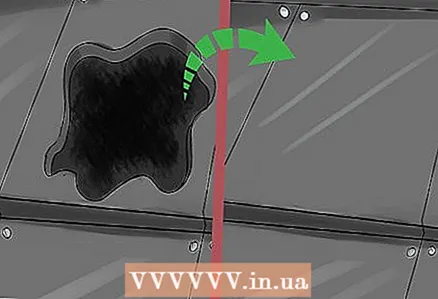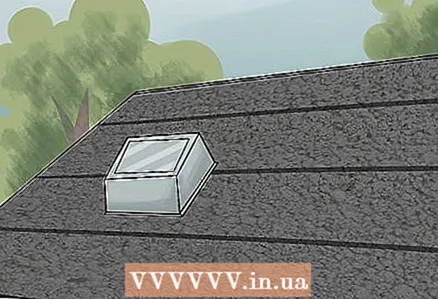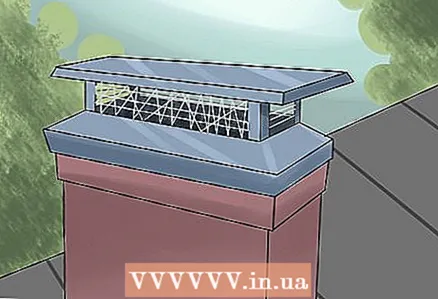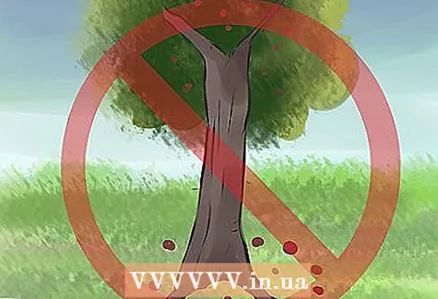Author:
Marcus Baldwin
Date Of Creation:
19 June 2021
Update Date:
1 July 2024

Content
The presence of animals living in the attic can cause serious damage to electrical wiring, plumbing and house structure, as well as become a source of illness. To prevent the appearance of animals, you need to constantly follow certain rules for caring for the house and the surrounding area. Frequent inspection of the attic and outside of the house, along with some preventive measures, will prevent the animals from settling over your head.
Steps
 1 Check the current state of affairs in the attic. If animals are found, you will need to either catch them yourself, or contact a specialist. Keep in mind: after taking preventive measures, it may happen that the animals already living in the house are trapped. This can lead to more serious damage to the home and the need to dispose of dead animals.
1 Check the current state of affairs in the attic. If animals are found, you will need to either catch them yourself, or contact a specialist. Keep in mind: after taking preventive measures, it may happen that the animals already living in the house are trapped. This can lead to more serious damage to the home and the need to dispose of dead animals. - Listen to the sounds coming from the attic. Record the timing and nature of the sounds. For example, the sound can be muffled, or similar to running or rolling. By the nature of the sound and the time of its appearance, you can determine what kind of animal settled in your attic. For example, squirrels give signs of their presence in the morning and as dusk approaches, since they are active during the day. You will hear rats and mice at night. Noise from larger animals (such as raccoons) will be louder.
- At the slightest suspicion, inspect the attic. If you haven't caught sight of anyone, look for traces of animals. This can be droppings, a nest, chewed wires, gnawed boards, holes gnawed out.
- Sprinkle flour in front of each hole that leads out. Leaving the attic in search of food, the animals will leave footprints. You can also loosely fill the holes with paper towels. Rodents will push them out, making their way through the hole.
 2 Examine the outside of the house. Most animals enter the attic through cracks, vents and chimneys. To get into the attic, raccoons and other larger animals can gnaw and dig inside small holes, making them larger. Find and seal all possible entrances from the outside of the house - this is the best way to prevent animals from entering the attic.
2 Examine the outside of the house. Most animals enter the attic through cracks, vents and chimneys. To get into the attic, raccoons and other larger animals can gnaw and dig inside small holes, making them larger. Find and seal all possible entrances from the outside of the house - this is the best way to prevent animals from entering the attic. - Walk around the house. Look for holes both in the roof and between the roof and the sheathing. Keep in mind that animals can get inside even through tiny crevices. A hole of 3.8 cm in diameter is sufficient for squirrels, and 9.5 mm for bats.
- Take the stairs and check out the places that cannot be seen while standing below. Check the roof architecture especially carefully. There may be holes covered with trim.
- Inspect all vents located under the eaves. There must be grates on them, and the openings of the grates should not be large so that animals cannot pass through them.
- Ventilation grilles located in the attic must be firmly attached. Otherwise, the animals will loosen the grate and make their way to your attic. Check the dimensions of the vents to make sure no animal can get in.
- Examine the chimney and see if you can get to the attic through it.
 3 Fill up any holes in the roof and under the arch.
3 Fill up any holes in the roof and under the arch.- Buy a metal mesh with 0.65 cm or 1.3 cm holes.
- Cut the mesh into pieces that are 20-30 cm larger than the hole you are filling.
- Attach the mesh with a construction stapler.
- Secure the mesh with U-nails.
 4 If you don't have ventilation grilles installed, buy and screw them on.
4 If you don't have ventilation grilles installed, buy and screw them on.- For greater reliability, from the inside of the attic, install a metal mesh 1, 3 cm or a steel grate above the ventilation openings. Attach it with a stapler or nails.
 5 Attach steel grilles to the ventilation holes. If animals can easily get into the attic through the vents, grates will provide reliable protection. ...
5 Attach steel grilles to the ventilation holes. If animals can easily get into the attic through the vents, grates will provide reliable protection. ... - Attach steel grates to the inside of the attic using U-nails. This will create a reliable barrier in the path of the animals. But do not use a grill with very small holes in order not to reduce the air flow.
- Install grates in the fall or winter whenever possible. Bats that can live in the attic will fly away to warmer regions by that time.
 6 Install the smoke hood. If your chimney opening is too large, you will have to buy and install a smoke hood to prevent animals from entering.
6 Install the smoke hood. If your chimney opening is too large, you will have to buy and install a smoke hood to prevent animals from entering. - Look for information on which type of smoke hood is best for your chimney. This is very important, as choosing the wrong hood can lead to a decrease in air flow or even a fire in the chimney.
 7 Make sure that there are no food in the yard - this way your attic will become less attractive to unwanted guests.
7 Make sure that there are no food in the yard - this way your attic will become less attractive to unwanted guests.- Close trash cans tightly. By the way, it is better to store them in the garage or hangar.
- It is better to feed pets in the house. If you feed them outdoors, take the bowls away immediately after feeding.
- Collect all fruits and nuts that fall from your trees.
- Only cover compost heaps with heavy lids. Animals can push back the light cover.
- Do not hang bird feeders in the yard.
 8 Hang a squirrel house in your yard. It is sometimes impossible to get rid of squirrels, especially if you live in a wooded area or value your trees. If it is easier for the squirrels to get into such a house, then you can offer them more comfortable housing instead of the attic.
8 Hang a squirrel house in your yard. It is sometimes impossible to get rid of squirrels, especially if you live in a wooded area or value your trees. If it is easier for the squirrels to get into such a house, then you can offer them more comfortable housing instead of the attic.  9 Remember to trim and remove tree branches. The branches that are located above the roof must be cut off so that access to the roof is limited.
9 Remember to trim and remove tree branches. The branches that are located above the roof must be cut off so that access to the roof is limited. - Check with a specialist if there is a risk that you will damage the roof by removing branches. Also, find out if cutting and pruning of trees will harm the trees.
Warnings
- Be sure to check your local regulations on what to do with the animals you catch. Each such animal must be released into the wild in a specially designated place.
- Mice, rats, raccoons and bats are carriers of diseases. Finding animals in your attic, be careful. Never try to catch them if you are not sure how to do it.
What do you need
- Flour
- Paper towels
- Stairs
- Ventilation grates
- Metal mesh with 0.65 cm or 1.3 cm holes
- Construction stapler
- A hammer
- U-shaped nails
- Steel grates
- Smoke hood
- Squirrel house



